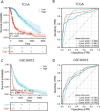Identification of mitophagy-related genes impacting patient survival in glioma
- PMID: 39923213
- PMCID: PMC11807950
- DOI: 10.1007/s12672-025-01916-6
Identification of mitophagy-related genes impacting patient survival in glioma
Abstract
Background: This study presents a new prognostic model using mitophagy-related genes (MRGs) in glioma, a type of brain tumor, developed through bioinformatics. The model seeks to improve the understanding of glioma prognosis by focusing on mitophagy, a cellular process that eliminates damaged mitochondria and influences tumor behavior and patient outcomes.
Methods: The expression profile and clinical information of patients were downloaded from TCGA (The Cancer Genome Atlas) and GEO (Gene Expression Omnibus). By analyzing the correlation between the 14 MRGs and glioma prognosis, we established a novel prognostic model in the TCGA training cohort and validated it in the GSE16011 dataset.
Results: Using univariate Cox regression, we identified 26 MRGs that were significantly enriched in various mitophagy-related pathways. After filtering variables using least absolute shrinkage and selection operator (Lasso) regression analysis, 14 MRGs were introduced to construct the predictive model. The survival analysis showed overall survival of patients with the high-risk score was considerably poorer than that with the low-risk score in both the training and validating cohorts (p < 0.01). The risk score was found to be an independent prognostic factor for glioma in both univariate and multivariate Cox regression analyses. Interestingly, Geneset enrichment analysis (GSEA) analysis revealed that multiple signaling pathways related to neurotransmission were significantly enriched in the high-risk group. Additionally, a hub miRNA-mRNA network was established, which disclosed the quantity and classification of miRNAs capable of interacting with 14 MRGs. Finally, our analysis revealed a notable association between 14 MRGs and immune functionality in gliomas.
Conclusion: We developed a robust and accurate prognostic model with 14 MRGs. Our findings might provide a reference for the clinical prognosis and management of glioma.
Keywords: Bioinformatics; Glioma; Mitophagy; Prognostic model; Risk score.
© 2025. The Author(s).
Conflict of interest statement
Declarations. Competing interests: The authors declare no competing interests.
Figures







Similar articles
-
Construction and validation of a metabolic-related genes prognostic model for oral squamous cell carcinoma based on bioinformatics.BMC Med Genomics. 2022 Dec 24;15(1):269. doi: 10.1186/s12920-022-01417-3. BMC Med Genomics. 2022. PMID: 36566175 Free PMC article.
-
Identification of Iron Metabolism-Related Genes as Prognostic Indicators for Lower-Grade Glioma.Front Oncol. 2021 Sep 9;11:729103. doi: 10.3389/fonc.2021.729103. eCollection 2021. Front Oncol. 2021. PMID: 34568059 Free PMC article.
-
Development and validation of a glioma prognostic model based on telomere-related genes and immune infiltration analysis.Transl Cancer Res. 2024 Jul 31;13(7):3182-3199. doi: 10.21037/tcr-23-2294. Epub 2024 Jul 22. Transl Cancer Res. 2024. PMID: 39145097 Free PMC article.
-
A novel signature derived from metabolism-related genes GPT and SMS to predict prognosis of laryngeal squamous cell carcinoma.Cancer Cell Int. 2022 Jul 8;22(1):226. doi: 10.1186/s12935-022-02647-2. Cancer Cell Int. 2022. PMID: 35804447 Free PMC article.
-
Construction and validation of a novel prognostic signature for uveal melanoma based on five metabolism-related genes.Math Biosci Eng. 2021 Sep 15;18(6):8045-8063. doi: 10.3934/mbe.2021399. Math Biosci Eng. 2021. PMID: 34814288
References
-
- Ducrot P, Joundi A, Diebold MD, Pluot M. Value of the nucleolar organizers (AgNOR) in brain gliomas. Arch Anat Cytol Pathol. 1991;39(3):88–93. - PubMed
-
- Alentorn A, Labussière M, Sanson M, Delattre JY, Hoang-Xuan K, Idbaih A. Genetics and brain gliomas. Presse Med. 2013;42(5):806–13. - PubMed
-
- Kirichenko EY, Savchenko AF, Kozachenko DV, et al. Connexin 43 expression in human brain glial tumors. Arkh Patol. 2017;79(2):3–9. - PubMed
-
- Lach B, Weinrauder H. Glia-specific antigen in the intracranial tumors. Immunofluorescence study. Acta Neuropathol. 1978;41(1):9–15. - PubMed
Grants and funding
LinkOut - more resources
Full Text Sources
